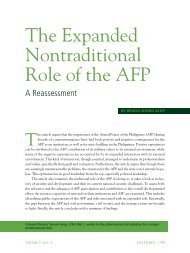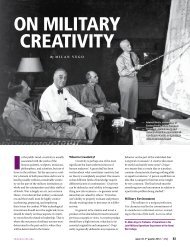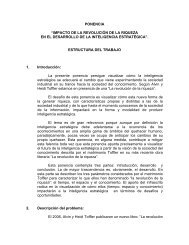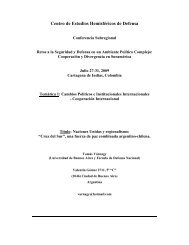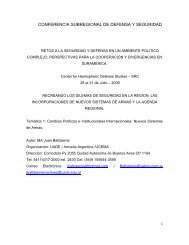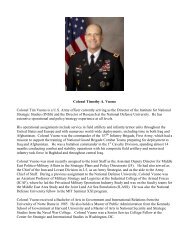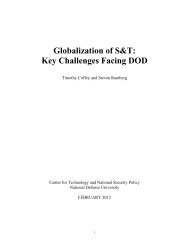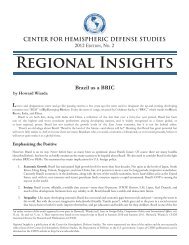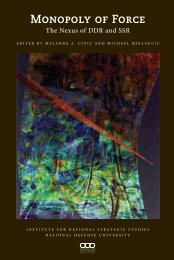On the Nature of Military Theory - National Defense University
On the Nature of Military Theory - National Defense University
On the Nature of Military Theory - National Defense University
Create successful ePaper yourself
Turn your PDF publications into a flip-book with our unique Google optimized e-Paper software.
20 TOWARD A THEORY OF SPACEPOWER<br />
Webster’s definition <strong>of</strong> <strong>the</strong>ory as “a coherent group <strong>of</strong> general propositions<br />
used as principles <strong>of</strong> explanation for a class <strong>of</strong> phenomena” 4 is a<br />
pretty good place to start. It highlights <strong>the</strong> essential task <strong>of</strong> explanation and<br />
<strong>the</strong> desirable criterion <strong>of</strong> coherence. But if we stand back a bit, we can tease<br />
out several o<strong>the</strong>r functions <strong>of</strong> <strong>the</strong>ory. The first two occur before its explanatory<br />
function. <strong>Theory</strong>’s first task is to define <strong>the</strong> field <strong>of</strong> study under<br />
investigation, or, in Webster’s words, <strong>the</strong> “class <strong>of</strong> phenomena.” In visual<br />
terms, this defining act draws a circle and declares that everything inside<br />
<strong>the</strong> circle is encompassed by <strong>the</strong> <strong>the</strong>ory, while everything outside it is not.<br />
In <strong>the</strong> <strong>the</strong>ory <strong>of</strong> war, for example, Carl von Clausewitz <strong>of</strong>fers two definitions.<br />
The first states baldly, “War is thus an act <strong>of</strong> force to compel our<br />
enemy to do our will.” 5 After introducing <strong>the</strong> limiting factor <strong>of</strong> rationality<br />
into <strong>the</strong> consideration <strong>of</strong> what war is, Clausewitz expands this definition as<br />
follows: “War is not a mere act <strong>of</strong> policy but a true political instrument, a<br />
continuation <strong>of</strong> political activity with o<strong>the</strong>r means.” 6 A syn<strong>the</strong>sis <strong>of</strong> <strong>the</strong>se<br />
two definitions would be that war is <strong>the</strong> use <strong>of</strong> force to achieve <strong>the</strong> ends <strong>of</strong><br />
policy. Although <strong>the</strong> utility <strong>of</strong> this definition has been argued at some<br />
length, it leaves no doubt as to what Clausewitz’s <strong>the</strong>ory is about. 7<br />
The next task <strong>of</strong> <strong>the</strong>ory is to categorize—to break <strong>the</strong> field <strong>of</strong> study<br />
into its constituent parts. Here it may be helpful to visualize <strong>the</strong> subject <strong>of</strong><br />
<strong>the</strong> <strong>the</strong>ory as a spherical object ra<strong>the</strong>r than a circle. The sphere can be<br />
divided in many different ways: horizontally, vertically, diagonally, or, if it<br />
is a piece <strong>of</strong> citrus fruit, into sections that follow <strong>the</strong> natural internal segmentation.<br />
Again, reference to Clausewitz is instructive. War has two temporal<br />
phases—planning and conduct—and two levels—tactics and<br />
strategy—each with its own dynamics. 8 Fur<strong>the</strong>rmore, wars could also be<br />
categorized according to <strong>the</strong>ir purpose (<strong>of</strong>fensive or defensive) and <strong>the</strong><br />
amount <strong>of</strong> energy (limited or total) to be devoted to <strong>the</strong>m. 9 A word about<br />
categorization is important here because it relates to <strong>the</strong> continuous evolution<br />
<strong>of</strong> <strong>the</strong>ory. Theories tend to evolve in response to two stimuli: ei<strong>the</strong>r<br />
new explanations are <strong>of</strong>fered and subsequently verified that more accurately<br />
explain an existing reality, or <strong>the</strong> field <strong>of</strong> study itself changes, requiring<br />
ei<strong>the</strong>r new explanations or new categories. An example <strong>of</strong> <strong>the</strong> former is<br />
<strong>the</strong> Copernican revolution in astronomy. 10 An example <strong>of</strong> <strong>the</strong> latter is <strong>the</strong><br />
early 20 th -century discovery <strong>of</strong> <strong>the</strong> operation, which emerged from <strong>the</strong><br />
industrial revolution’s influence on <strong>the</strong> conduct <strong>of</strong> war, as <strong>the</strong> connecting<br />
link between a battle and a campaign and subsequently led to <strong>the</strong> study <strong>of</strong><br />
operational art as a new subdiscipline <strong>of</strong> military art and science. 11<br />
The third, and by far <strong>the</strong> most important, function <strong>of</strong> <strong>the</strong>ory is to<br />
explain. Webster’s definition cited above is correct in emphasizing <strong>the</strong>ory’s



